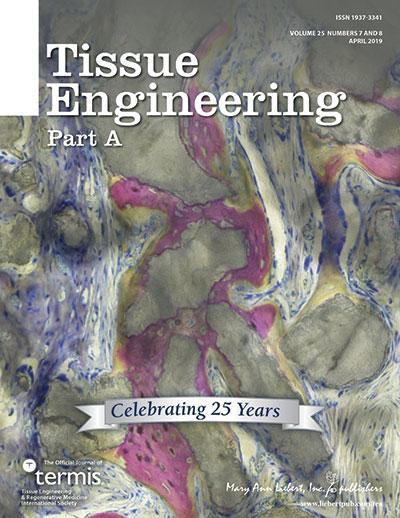
Credit: (c) 2019 Mary Ann Liebert, Inc., publishers
New Rochelle, NY, May 9, 2019-Repair of cartilage injuries or defects is aided by the introduction of mesenchymal stem cells (MSCs), which can be incorporated into hydrogels to amplify their effects. In a new report, researchers directly compared chondrogenic induction by hydrogels that were prepared using MSCs either as single cell suspensions or as 100-500-cell micropellets. The study is published in Tissue Engineering, a peer-reviewed journal from Mary Ann Liebert, Inc., publishers. Click here to read the article for free on the Tissue Engineering website until June 9, 2019.
Fan Yang, PhD, and colleagues from Stanford University, CA present their work in an article titled “Comparing Single Cell vs. Pellet Encapsulation of MSCs in 3D Hydrogels for Cartilage Regeneration”. The authors first identified the optimal size of MSC micropellets that allowed homogeneous incorporation into hydrogels while retaining viability. Four different hydrogel preparations were then tested, and in each case, single cell suspensions were pitted against micropellets to assess chondrogenesis. Additional biochemical assays and histological staining were performed to validate and qualitatively assess cartilage formation, ultimately providing guidance for future cartilage regeneration efforts.
“Dr. Yang and her colleagues at Stanford have shown that traditional pellet culture of cartilage cells may be translated into cartilage engineering approach for mesenchymal stem cell-based cartilage formation,” says Tissue Engineering Co-Editor-in-Chief John P. Fisher, PhD, Fischell Family Distinguished Professor & Department Chair, and Director of the NIH Center for Engineering Complex Tissues at the University of Maryland. “This exciting work has broad implications for not only cartilage, but also other stem cell populations and even models of cancerous tumors.”
###
About the Journal
Tissue Engineering is an authoritative peer-reviewed journal published monthly online and in print in three parts: Part A, the flagship journal published 24 times per year; Part B: Reviews, published bimonthly, and Part C: Methods, published 12 times per year. Led by Co-Editors-in-Chief Antonios G. Mikos, PhD, Louis Calder Professor at Rice University, Houston, TX, and John P. Fisher, PhD, Fischell Family Distinguished Professor & Department Chair, and Director of the NIH Center for Engineering Complex Tissues at the University of Maryland, the Journal brings together scientific and medical experts in the fields of biomedical engineering, material science, molecular and cellular biology, and genetic engineering. Leadership of Tissue Engineering Parts B (Reviews) and Part C (Methods) is provided by Katja Schenke-Layland, PhD, Eberhard Karls University, Tübingen, Heungsoo Shin, PhD, Hanyang University; and John A. Jansen, DDS, PhD, Radboud University, and Xiumei Wang, PhD, Tsinghua University respectively. Tissue Engineering is the official journal of the Tissue Engineering & Regenerative Medicine International Society (TERMIS). Complete tables of content and a sample issue may be viewed on the Tissue Engineering website.
About the Publisher
Mary Ann Liebert, Inc., publishers is a privately held, fully integrated media company known for establishing authoritative peer-reviewed journals in many promising areas of science and biomedical research, including Stem Cells and Development, Human Gene Therapy, and Advances in Wound Care. Its biotechnology trade magazine, GEN (Genetic Engineering & Biotechnology News), was the first in its field and is today the industry’s most widely read publication worldwide. A complete list of the firm’s 80 journals, books, and newsmagazines is available on the Mary Ann Liebert, Inc., publishers website.
Media Contact
Kathryn Ryan
[email protected]
Original Source
https:/
Related Journal Article
http://dx.




